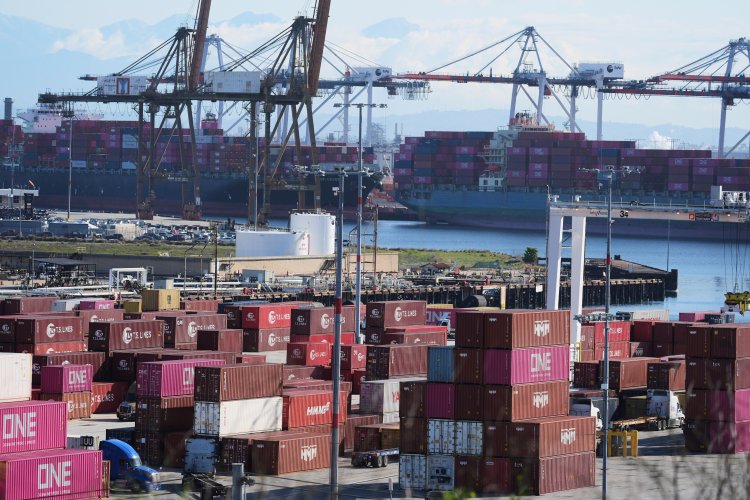America's Biggest Port Faces Challenges Navigating Trump's Tariffs
Gene Seroka, the Executive Director of the Port of Los Angeles, addresses the potential challenges that tariffs may pose to the American economy.

Gene Seroka serves as the executive director of the Port of Los Angeles, which, when paired with the nearby Port of Long Beach, handles about one-third of America’s imports and exports. This places Southern California in a particularly vulnerable economic position following the introduction of a 10 percent tariff on all imported goods by Trump, with even steeper rates imposed on partners including China, Japan, and the European Union.
Seroka faces the challenge of coordinating a complicated network that includes international corporations, small businesses, and thousands of employees, all amidst what he describes as a significant void of information from the administration regarding its plans.
"You’ll see folks that have to scramble pretty quickly to keep their jobs and keep food on the table. It's going to be disruptive," he remarked.
In an interview with PMG, Seroka discussed the imminent effects of tariffs on the American economy, the potential job losses in California, and the critical lack of information within the trade sector.
This interview has been edited for length and clarity.
What immediate impact on imports can we expect if these tariffs remain in effect?
The primary issue at play has been uncertainty regarding when and how tariffs will be implemented, as well as their larger implications. The conversation began during last summer's campaign, when the president indicated a desire for widespread 10 percent tariffs on all $3 trillion of U.S. imports, targeting specific countries like China, Mexico, and Canada. Now we're witnessing those predictions unfold.
Over the previous eight or nine months, many large companies capable of moving inventory forward have done so to avoid the uncertainties surrounding the impending tariffs. However, small to mid-sized firms, lacking the same resources, remain vulnerable to current market prices and conditions.
"As your costs rise, small businesses will negotiate with manufacturers and sourcing agents overseas to mitigate additional charges," noted Seroka. Companies may also consider absorbing costs, which could affect profits and lead them to be hesitant about investments in human capital. Most likely, they will increase prices in the supply chain for finished goods, resulting in higher costs for consumers.
Looking ahead, the outlook appears grim. Consumer confidence has significantly declined, casting uncertainty on jobs and investment levels.
When should we expect to see a decline in cargo volumes?
I believe that starting July 1 and extending through the year, we might see a cargo drop of at least 10 percent at the Port of Los Angeles. This decline is due to two key factors: many have already shipped large volumes of cargo, and higher prices are prompting companies to seek other sourcing options. If China remains a focal point politically, alternatives in countries like Vietnam, Indonesia, and Malaysia may emerge.
As we transition through the traditional post-Lunar New Year slowdown in Asia, American retailers will focus on seasonal products and upcoming model years for various goods. This could result in a mixed impact—though a drastic decline isn't expected, shifts in demand toward seasonal and essential items will occur.
What are the implications of a port slowdown on Southern California's supply chain-related jobs?
The ramifications are significant. In Southern California, approximately one in nine jobs—around a million—are tied to the activities stemming from this port. This encompasses various roles, including stock workers, truck drivers, warehouse staff, and Customs agents. A reduction in cargo of about 10 percent translates to fewer jobs available.
While specific positions, such as longshore mechanics, are essential and will remain secure, other workers may need to pivot to domestic freight or alternate routes to maintain employment. "You’ll see folks who have to scramble pretty quickly to keep their jobs and keep food on the table," Seroka reiterated.
Additionally, the economic repercussions extend to tax revenues generated by port operations. With reduced cargo movement, fewer workers show up each day, leading to decreased utility use and subsequent declines in municipal tax revenues.
In summary, the economic effects will be undeniable, with rising consumer prices and diminished productivity within the supply chain contributing to a slower economy.
What has been your communication with the Trump administration regarding its strategy?
There has been very little communication, and I'm eager for insights to guide my operational decisions.
Much of my recent time has been devoted to discussions with various importers and exporters—from large corporations to local family-owned enterprises. The consistent feedback is that companies are investing excessive effort in modeling potential scenarios driven by policy changes and tariffs, diverting focus from their core operations. As a result, productivity has suffered.
Do you have any predictions about the duration of the current tariffs?
The duration remains unclear; I can only express my belief in the need for rules-based trade that protects American jobs and interests. "Ninety percent of world trade moves on water," Seroka emphasized, indicating the port's crucial role in both national and global supply chains.
The administration has hinted at negotiations and deal-making, but the specifics remain elusive. Given the rapid changes in policy direction early in this administration, I remain hopeful that constructive dialogue will occur between key trading partners and the administration to facilitate trade continuity in the American economy.
“I don’t know how long this could last, but I do know things can shift quickly,” Seroka concluded, expressing optimism for a favorable resolution.
Ian Smith for TROIB News
Find more stories on Business, Economy and Finance in TROIB business












